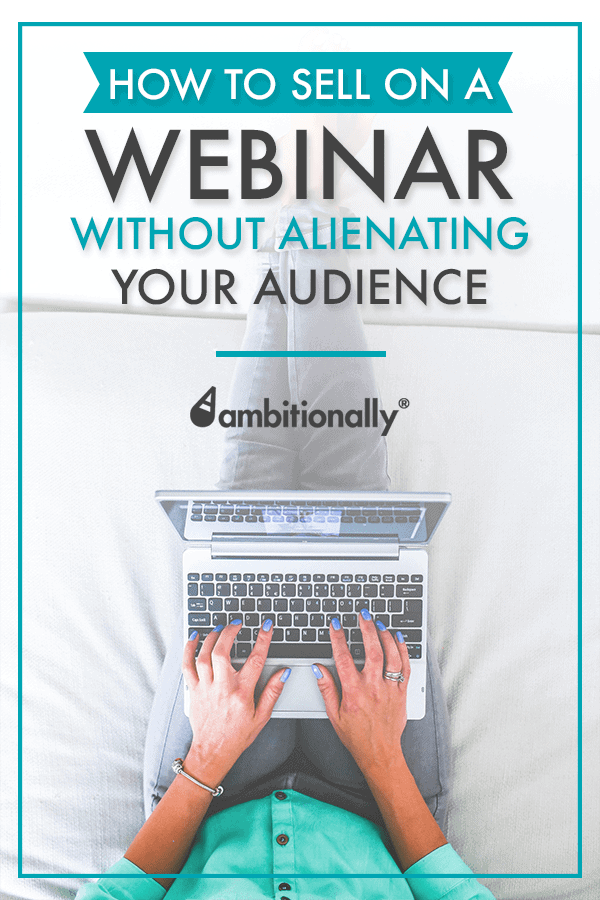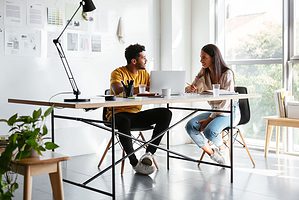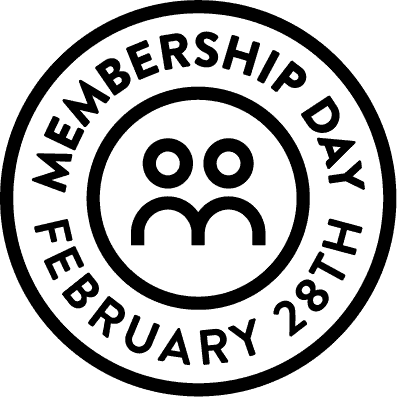I was at a conference a few years ago where there were several guest speakers. Each one was allowed to pitch a product from the stage.
Now, I always like to look around me when I’m listening to a presentation, to see how other people are reacting to a speaker’s message. It’s easy to know how we react, but it’s definitely a good practice to get a feel for how others are receiving the same information.
Why is it so important to get good at reading an audience?
To bring it a little closer to home, it’s especially important to be able to read an audience if you ever plan to present an offer or pitch a product during a webinar.
When you’re hosting a webinar, you’re alone in a room. You don’t know how people are reacting unless they’re typing into the chat … or worse, leaving in droves.
So let’s get back to that conference story, because it illustrates how easy it is to fall into one of two extremes: over-hyping and underselling.
Both can be dire for your business, and for your ability to make money from your webinars.
The Loud, Overly Practiced Storytelling Salesman
The first guest speaker to take the stage was a young businessman, who had clearly given this exact talk at least a dozen times before.
It was also obvious that he must have worked with a speaking coach on his delivery. His presentation was king of like a play: there were emotions, he varied his tone to add emphasis on certain key moments of his story, and he used a ton of body language.
I can guarantee you that no one was falling asleep or getting bored during his talk.
The only problem was …
He really didn’t deliver a ton of valuable advice – or anything concrete for the audience.
Instead, we were all left feeling like we had listened to a good story (maybe an overly dramatized version of the truth) … and then got pitched a sales offer.
This didn’t allow us to test whether this guy had anything of value to share, and it definitely made it less appealing to take him up on his product or coaching offers.
This hurt his sales, because although he did establish rapport with each of us in the audience by sharing his triumphant story, he wasn’t reading the room.
He didn’t realize that this particular crowd needed more “how-to” and education in order to trust him or open up their wallets.
At the end of his talk, we felt disappointed. It felt like he was holding out on his “secrets to success” by just sharing his story… as if all he wanted to do was make a sale, instead of giving us something of value to take home.
The takeaway:
You don’t want to be this type of presenter on a webinar, because you’ll lose people as soon as they feel you’re not sharing “the good stuff” with them. There’s nothing less appealing than feeling like you’re only there for a sales pitch.
The Nervous, Oversharing, “Too Much Content” Woman
A little later on in that same conference, a young businesswoman took the stage. It was a totally different experience from the “salesman” presenter. Instead of telling an emotional story that was overly rehearsed… this speaker chose to become a “fire hose” of information.
Her presentation was so packed with “how-to” and training information, that it was difficult for the audience to follow along. She had a lot of great ideas and tactics to share, but because of the short amount of time she had to deliver them, the talk felt especially rushed.
Because she was speaking faster, she also appeared more nervous. This, in turn, made it harder for the audience to stay engaged.
On top of it all, because she was so focused on providing as much technical value as possible to the audience, she didn’t end up sharing anything about her own story. This made it hard for us to get to know her.
The overall effect of her pitch definitely hurt her sales because there was no way for us to know how she was different from other trainers in her industry. She didn’t give us a reason to like her, beyond the information and the facts that she shared.
Oh, and because she was so focused on getting through her talking points, it was difficult for her to transition seamlessly to the sales offer. It felt like an abrupt change when she started talking about her product.
The takeaway:
You don’t want to be an impersonal “oversharer of content” during your webinars … for a couple reasons.
First, it’s overwhelming to your attendees and they won’t be able to follow through on what they learn.
Second, it doesn’t help you sell because it’s not personal enough. If you’re not letting your personality shine through, it can even be a bit boring to listen to.
Crafting Your Webinar Pitch “Just Right”
Both of these examples illustrate how easy it is to stray from one end of the “sales-y” spectrum to another.
In the first example, the presenter is overly confident in his story and his pitch being able to win people over. In the second example, the presenter is lacking confidence in her ability to win people over so she overcompensates by giving more content.
Neither of these options is ideal for your audience, or for you. But it can be tricky to craft your webinar slides and presentation with the right mix of personality, story, and actual actionable advice or facts.
This is a classic case of Goldilocks and the 3 little bears… You want your webinar to be “just right” for your audience.
Here’s how you do just that…
1. Pick Your One, Big, Unforgettable Takeaway
It’s easy to err on the side of over-delivering content, like the second speaker in my story.
After all, we want to give enough of value to our audiences as a “thank you” for giving us their time and attention.
But here’s the thing: you’ll serve your audience even more if you focus your webinar on delivering one, key, unforgettable takeaway… That way, even a year from now, the webinar participants will be able to remember what your webinar was about and how it applies to them.
Packing in too many ideas or concepts will dilute your talk, and might confuse a listener who doesn’t know where they should begin.
Don’t be afraid to repeat your one big idea throughout your webinar. People are more likely to really let it sink in if you approach the same topic from different angles.
So: Pick one key message you want people to leave with, ideally something that connects to what it is you’re selling.
2. Introduce Your Topic With A Story (Why Should We Care?)
You don’t want your entire webinar to be about you or your story, but you do want to give some context to your information; so that people know why it’s important.
If you have a personal anecdote that relates to your big takeaway and your sales offer, then it’s probably something that will benefit your audience … that way they can see how this information might apply in their life.
You can also talk about your credentials or personal experience around the topic you’re pitching, to give your listeners even more of a reason to trust what you’re sharing with them.
3. Deliver Value To Whet Their Appetite
This is where you “give them the goods”. You don’t have to hold back here on giving them real actionable information … just make sure to you focus all of your advice around your key takeaway so it won’t feel as overwhelming.
When you’re delivering these meaty tips, you’ll quickly realize that you know more about this topic than what will fit in a 60 minute presentation. And that’s where you can naturally create demand for a product or service offering. It makes for a much easier transition into your sales pitch without feeling slimy.
As you continue to deliver value to your audience, you’re really proving to them that they can trust you, as well as giving them a hint of the great stuff they can buy through your products or services.
4. Offer A Way To Go Further
It’s important to empower your audience, to offer them a way to go further if they’re ready for it. Not everyone will be at a point where they will take advantage of this … but not one member of your webinar audience wants to feel “stuck,” like there’s no way to really run with the information that you’ve given them.
Of course, it might be tempting to pitch your product or service like it’s the only next step. But trying to pigeonhole someone into purchasing your stuff definitely isn’t going to win your audience over!
Realistically, it’s much better to spend a bit of time describing why your product will really help them take the next step, while also touching on the fact that there are alternatives.
Those who aren’t quite ready to make a purchase will appreciate your efforts, and those who are going to invest in your offer will value your honesty.
After all, it’s much easier to trust someone who truly cares about your success.
[Tweet “It’s much easier to trust someone who truly cares about your success.”]
5. Reiterate The Takeaway and Leave Them Satisfied
The final thing you say in your webinar will leave a lasting impression on your audience. What impression do you want to leave them with?
It might be tempting to let your sales offer sit with them … but don’t give in.
Instead, reiterate the key takeaway that you’ve given them through your presentation. They’ll be satisfied knowing that you’ve truly emphasized something of value to them – something they can take with them.
Your key takeaway is a free gem that your audience can enjoy whether or not they decide to buy your product.
But here’s a secret: when you leave them with your key takeaway instead of the sales pitch, you’ll increase the likelihood of making the sale after all.
More Webinar Hosting Resources
Learning how to sell on a webinar is key to making the whole event profitable for your business.
But if you’re looking for a great net step to get started, I’d definitely recommend taking a look at the software you’re going to use to host your webinar.
If you haven’t already, definitely check out a few of the options on this shortlist of webinar tools:
- CrowdCast: This is another YouTube Live based webinar solution, with built-in chat and additional features that make it easy to organize live events.
- Facebook Live: You can easily host live videos directly on your public Facebook page, that instantly turn into re-watchable videos.
- Webinar Jam: This is another YouTube Live based webinar solution, that has a lot of additional features like landing pages and email integrations.
- Zoom: If you’re looking for a non-YouTube or Facebook option, this is one of the top contenders that is very affordable.
- GotoWebinar: This is the corporate standard that works great if you have a smaller audience or the budget to invest in quality webinars.
There are so many great options out there for you to choose from, but the important thing to remember is that your goal is to connect with your audience and deliver value to them in such a way that it leaves them wanting more. So choose your words – and tools – carefully, and boldly share your wisdom with your webinar audience.






